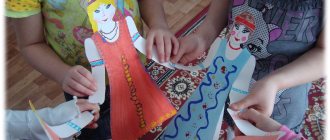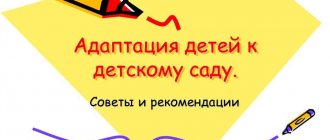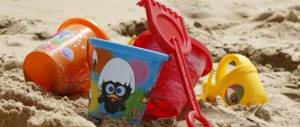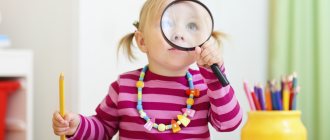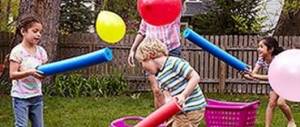We started drawing at about 1 year old. At first Antoshka did it with finger paints in the bathroom. A couple of months later, my husband made an easel, and my son became acquainted with brushes and gouache.
Basically, the child draws whatever he wants with the materials he wants or that I provide. Free drawing should be practiced as often as possible. But don't stop there.
In this article I will share drawing ideas with children aged 1 – 3 years old, I will talk about various techniques for drawing with paints, pencils and other materials, even shaving foam.
You can also use finger painting templates for the little ones.
I won’t talk at length about the benefits of drawing with children. I think you already know very well that it develops the child’s imagination, creativity, improves hand coordination and fine motor skills of the fingers.
How to draw with a child 1-3 years old
In the article about applications, I talked about the book by E.A. Yanushko . This author also has a book called Drawing with Young Children (Labyrinth). This is an excellent teaching tool for parents and teachers, and it also comes with a CD with demonstration materials.
The book presents a methodology for conducting drawing classes with children 1 – 3 years old . I take many ideas from her.
Before you start drawing with your child, here are some simple tips from me:
- Show your child various drawing techniques (pokes, strokes, stamping, etc.) gradually, starting with the simplest ones.
- I highly recommend buying or making your own easel for painting. It is relevant as soon as the child learns to walk.
- Draw as often as possible.
- Use a variety of drawing materials.
- Try to immediately teach your child to hold a brush and pencil correctly. But if the child stubbornly refuses to do this, do not insist.
- Give your child maximum freedom. Let the child draw what he wants and how he wants. Never demand that he draw the way you want. Below I will talk about various drawing techniques with children, but if the child refuses to do something, do not insist.
Don't correct your child! Let him draw purple skies and red grass. So what if cows don't fly and there are no fences on the rainbow? Your child's mind is still free from cliches. He is a true creator.
Teaching your child to draw: where to start?
I have already written about early introduction to the fine arts, but the topic is so large and controversial that I will return to the question: at what age should we start teaching children to draw? In general, it’s worth saying that many parents don’t even realize that teaching any type of fine art or handicraft is mandatory. The children themselves will not figure out how to draw or cut or sculpt correctly, so that they can depict their plans.
You often hear from mothers: oh, my son can’t draw at all, he’s just like me. But, as practice shows, everyone can be taught to depict objects on paper. Children with insufficient development show wonderful results and talents. And healthy children can even master the intricacies of using a pencil and brush.
There are effective trainings even for adults, step-by-step lessons, master classes. If there was a desire... Another thing is that kindergarten teachers are not able to make an artist out of every child. We give basic skills to children, but parents must specifically develop their talents. Needless to say, long before kindergarten a child can master the basic wisdom of fine arts.
So, as soon as your baby begins to sit well, freely, firmly, you can offer to draw. The first step is up to you: if you are ready for paint stains on all surfaces, including the artist himself, use finger paints. Big Whatman paper to help you! Your task is to show your child what can be done with paint. Give one color first and show how you can draw a line on the paper with your finger. Look at the baby’s mood - at the first sign of loss of interest, switch your attention to something else. At this stage, it is important to arouse interest in drawing.
If you're not up for the extra work of scrubbing everyone and everything off the paint, work with a pencil or wax crayon. Start your fun lesson games right at the feeding table. Show your child how to hold a “tool” of work, how to draw a line correctly, etc.
As for the number of classes, do not overdo it, 1-2 times a week is enough.
How to draw with your child
The more different art materials you use, the better.
You need to start with the easiest to learn (for example, finger paints), eventually reaching regular pencils.
We draw on:
- plain paper
- old wallpaper,
- easel,
- magnetic board,
- plaster figures for coloring,
- wood, plywood,
- fabrics,
- tiles in the bathroom and in the bath itself.
For drawing with children 1 – 3 years old, you can use the following materials :
- Finger paint;
- gouache, watercolor (and, accordingly, brushes of different sizes);
- felt-tip pens (water-based and regular);
- crayons (wax and regular);
- wax pencils;
- dry pastel;
- pencils (preferably soft ones);
- gel and ballpoint pens;
- foam rubber, sponges;
- cotton swabs and cotton wool;
- stamps;
- semolina;
- shaving foam.
You will also need a glass for water (preferably a sippy cup) and a palette for mixing paints.
MAGAZINE Preschooler.RF
The use of non-traditional drawing techniques in the second group of early age.Early age plays an important role in the development of mental processes. The most significant and relevant at this age is drawing. Drawing is a very interesting and at the same time complex process.
Using various drawing techniques, including non-traditional ones, the teacher instills a love of fine art and arouses interest in drawing. In kindergarten, a wide variety of methods and techniques of non-traditional drawing can be used. Many scientists believe that all types of non-traditional drawing can be introduced from an early age, introducing children to the features of the technique. The only difference is the degree of participation of the teacher in the drawing process.
There are many non-traditional drawing techniques; their unusualness lies in the fact that they allow children to quickly achieve the desired result. For example, what kind of child would be interested in drawing with his fingers, making a drawing with his own palm, putting blots on paper and getting a funny drawing. Visual activities using non-traditional materials and techniques at an early age contribute to the child’s development of:
- Fine motor skills and tactile perception;
- Spatial orientation on a sheet of paper, visual perception;
- Attention and perseverance;
- Thinking;
- Observation, aesthetic perception, emotional responsiveness;
Taking into account the age characteristics of my students, I use special techniques, methods and types of drawing to master various non-traditional drawing skills.
- Technique of “drawing with hands” (palm, fist, fingers).
- “tamponing” technique involves making stamp impressions with crumpled paper or foam rubber.
Each of these techniques is a small game. Their use allows children to feel more relaxed, bolder, more spontaneous, develops imagination, and gives complete freedom for self-expression.
Children with curiosity, joy and pleasure smear traces of paint on their palms and on paper. After several training games, a motor rhythm appears on the worksheet, as children repeat movements with their palms and fingers many times. This rhythm attracts children, becoming an additional incentive for actions with paint and increasing interest in them. During the learning process, I complete each image with the children (dipping my finger in the paint, we draw eyes, a nose, a mouth, a tail, while using abrupt lines, horizontal, arcuate lines).
When drawing with their palm, children first leave a handprint on a sheet of paper, and then complete the drawing themselves, showing by their example the principle of the image.
Finger painting and palm drawing help the child feel the freedom of creativity, give a feeling of interaction with visual material without a brush, since most of the child’s attention and energy (especially at the early stage of development of visual creativity) is occupied by the process of mastering the instrument.
One of the types of seals is padding or imprinting. For this exciting activity, I use a foam rubber or crumpled paper tampon. Children pick up paint and, with a soft touch on the paper, draw something fluffy, light, airy, transparent or prickly. This technique is best suited for drawing animals, as it conveys the texture of the furry surface of the object. This technique ensures maximum success in creating creative work, regardless of the child’s visual skills.
For painting with crumpled paper, it is better to use glossy thin paper, since it crumples well into dense lumps, forms sharp edges, and slowly soaks in paint. Depending on the purpose of drawing, the paper can be compressed into small or large balls, while adjusting the density of the folds. It is important to note that for each color used in the drawing, a separate ball of paper is needed, so you should prepare a sufficient amount of them.
Teaching drawing in unconventional ways to young children allowed them to reveal their creative potential, increase interest in artistic activity, and develop mental processes. When drawing, children feel more relaxed, bolder, more spontaneous.
| Next > |
Finger painting
As I already said, we started painting with finger paints around the age of 1 year. And they did it in the bathroom. Then we switched to paper.
Finger paints are safe and do not require the use of water. You can replace them with gouache.
The simplest thing you can do is draw dots with your fingers:
- grains for birds, peas;
- apples, berries, cones, balls for the Christmas tree;
- watermelon seeds;
- raindrops, snow, animal tracks;
- spots for giraffe, ladybug, leopard.
You can draw dots with your fingers using ready-made templates.
DOWNLOAD TEMPLATES for finger painting in one file.
And of course, let the baby smear the paint all over the sheet with his fingers and palms.
Drawing techniques with paints and pencils
All drawing techniques involve the use of different materials depending on the age and capabilities of the child. We give paints, crayons, felt-tip pens to very young children, and pencils, etc. to older children.
I list all the techniques in order of increasing complexity .
Free drawing
My son calls this kind of drawing “scribbles”.
We introduce the child to drawing materials and give him the opportunity to experiment. At the same time, there is no need to give any tasks to draw something specific.
Practice free drawing as often as possible at any age of the child. It perfectly develops imagination.
Painting a sheet
We give the child paints, crayons, etc. and we suggest drawing:
- grass for the cow,
- water for fish,
- sand, snow.
The child needs to paint over the sheet, and not draw individual blades of grass, etc. Even a one-year-old can cope with this task.
paint rollers here - plain or shaped.
Shading an element
We draw a base (small images of animals and various objects) and ask the child to hide them by painting them over:
- hide the mouse, bunny, fish, bug;
- hide the moon and stars, the sun, the car.
With very young children it is interesting to do this with a sponge; with children over 2 years old it is useful to paint over elements with pencils.
Drawing points
Pre-draw the basis for the drawing - a bird that the child will feed, a bush on which berries will grow, etc.
Invite your child to draw: grains, berries, snow, raindrops, a bagel with poppy seeds, freckles, polka dots on a dress.
Drawing lines
- Direct: rays of the sun, stems of flowers, tops of carrots, fence, cage, path, rails, paws of bugs, needles of a cactus, teeth of a comb.
- Wavy: boat waves, worms, octopus legs, car tracks, hair.
- Broken: slides, a fence, icicles, a road with turns, thorns for a hedgehog.
Draw circles, ovals
Balls, apples, candies, Christmas tree decorations, beads, balloons, rowan berries, berries, bubbles, eggs, cones.
Drawing Spirals
Invite your child to draw: a snail's house, smoke, a bee's flight, curls, sheep's rings, threads.
Finishing the drawing
Antoshka really likes to play this game: I say that one boy drew different figures, but did not finish them, and I suggest that my son finish them. He does this with great pleasure. This is how we finish drawing:
- geometric figures;
- I draw a road (a broken line) and Antoshka repairs it,
- any simple and understandable drawings.
Drawing simple stories
This is the most difficult stage in mastering drawing. Here the child combines different drawing techniques according to the instructions of an adult.
Take turns asking your child to draw different elements that will eventually turn into something specific. But give your child as much freedom as possible.
The purpose of such drawing is to show the child how the finished image appears step by step.
Unconventional ways of drawing with young children
Article “Unconventional methods of drawing with young children: pros and cons.”
Author: Galina Yuryevna Eryshova, teacher of the MBDOU “Kindergarten No. 32” in the city of Arzamas, Nizhny Novgorod region. Description of the material: this material will be useful to educators, additional education teachers and all those who are concerned about the problem of visual activity of younger preschoolers. Goal: increasing psychological and pedagogical competence on the issue of organizing visual activities with young children using non-traditional drawing methods. One of the priority areas ensuring the development of the abilities and creative potential of each child in the Federal State General Education Standards of Preschool Education is the artistic and aesthetic development of preschoolers. Currently, the problem of visual activity is of particular relevance, as it contributes to the perception and emotional response of children to beauty in the world around them - nature, human relationships, in the world of things. The formation of prerequisites for the perception and understanding of the natural world, the formation of an aesthetic attitude towards the surrounding world begins from a very early age. It is during this period that the child’s connection with the world of people, nature, and the objective world is established, he is introduced to universal human values, curiosity develops, and an interest in creativity is formed. The problem of visual activity of children in kindergarten was once dealt with by N.P. Sakulina, N.B. Khalezov, a number of researchers led by N.A. Vetlugina (T.G. Kazakova, V.A. Ezikeeva - in the field of drawing), A.V. Bakushinsky, D.B. Bogoyavlenskaya, A.A. Wenger. The authors studied children's creativity in general, its originality, developmental features, ways and methods of influencing children. Unconventional drawing techniques are interestingly presented in the works of G.N. Davydova, D.N. Koldina and others. • “To receive the beginning of aesthetic education in childhood means to acquire a sense of beauty for the rest of your life, the ability to understand and appreciate works of art, and to become involved in artistic creativity.” (N.A. Vetlugina). • “Fine art is the first, most accessible and attractive form of creative work for children.” (L.S. Vygotsky). • “It is necessary and possible to search for ways of interaction that, on the one hand, preserve the advantage of children’s creativity, and on the other hand, will help the child master the means of self-expression.” (N.P. Sakulina). Young children are constantly in a state of exploring the world around them. It is very important to teach beauty from a very early age. And what could be a more clear example for understanding beauty than fine art? Drawing for a child is a joyful, inspired work, to which he should not be forced, but it is very important to stimulate and support the child, gradually opening up new possibilities for visual activity. A peculiarity of teaching fine arts is that two main approaches , which can be defined as academic teaching and free education. In the first case, children are taught to depict objects in accordance with the requirements of realistic fine art. With such a system of education, children can acquire some skills that are useful in many specialties and everyday situations, but they do not gain experience in solving artistic problems and do not become familiar with art. This is learning without creativity. In the second case, a favorable environment and conditions for creativity are created for children without providing targeted pedagogical influence. They gain the experience of free self-expression, communication with artistic materials, etc. But this is creativity without learning. It rises on the wave of “age-related talent,” as if apart from the child himself, and with it fades away. The little artist does not “take control” of his own creative potential. A third way is needed —the path of purposeful guidance of children’s creative development. The first thing to think about is that the child is a creative subject. It must be taken into account that no one except the child himself will give the “correct” solution to the creative problem facing him (for example, if a child is looking for a combination of colors that expresses a certain feeling, he is solving a truly artistic problem). It is very difficult for children of primary preschool age to depict objects, images, plots using traditional drawing methods: with a brush, pencils, felt-tip pens. Using only these objects does not allow children to develop their creative abilities more widely. They do not contribute to the development of imagination and fantasy. But you can draw with anything and however you want! Non-traditional drawing techniques have recently become especially popular in preschool institutions . Unusual things are always interesting! Firstly, kids are pleased with the quick achievement of results! So you dip your finger into the paint, put a dot, another, and another - and the result is impressive: bright, ripe bunches of rowan appeared on the sheet. And on this sheet there is a picture of a cloud, a little inspiration - and ringing drops of rain poured from the cloud! Here's the first advantage of unconventional drawing: getting a vivid image in a short period of time. Secondly, you can draw with anything and however you want! There are no rules for you, no templates for teaching a child the visual arts. Let's take for example the seemingly contradictory technique of drawing with stamps. Drawing with stamps is liked by all children and even adults without exception. When drawing this way, children are not afraid to make mistakes, since everything can be easily corrected, and it is easy to come up with something new from an erroneous image. As a result, the child gains self-confidence, overcomes the “fear of a blank sheet of paper” and begins to feel like a little artist! He develops an interest, and with it a desire to draw. So the kid takes a circle stamp in his hands, puts an imprint, another one - and the clown has multi-colored balls in his hands, so beautiful! Both the baby and the clown are smiling, they are very pleased with the result! A little imagination and creativity = and the bouquet in the vase “comes to life”... Who would have thought that the blossoming tulips are an imprint of a stamp from an ordinary cabbage leaf... And this “worked” with a stamp made from potatoes - fish appeared in the aquarium; an ordinary half of an apple created a beautiful still life composition. Drawing with stamps attracts with its simplicity and accessibility, revealing the possibility of using well-known objects as artistic materials. This is especially evident when working with young children, when they have not yet developed the skills to work with paints and brushes. Thirdly, the most important thing is that non-traditional drawing plays an important role in the mental development of a child. After all, it is not the final product-drawing that is valuable in itself, but the development of personality: the formation of self-confidence, one’s abilities, self-identification in creative work, and purposefulness. There are many more positive aspects to note in using non-traditional drawing with young children, and all of them will be significant and significant. • During such activities, not only vision and understanding of beauty develops, but also imagination, dexterity, ingenuity, and curiosity. • Non-traditional techniques stimulate positive motivation and contribute to the expression of the child's individuality. • The use of non-traditional techniques in visual arts develops not only the sensory sphere through the perception of the surrounding world and displaying what is seen on paper, but creates enormous opportunities for studying the properties of objects (paints, types of paper, auxiliary elements...). • Fun and unusual drawing techniques create a relaxed atmosphere of interaction between adults and children. The child learns and develops without noticing it. The drawing process turns into an exciting educational game. • And the great thing is that regardless of the child's artistic abilities, each work will be unique and magnificent. • Non-traditional drawing techniques develop a sense of initiative, make the child more independent and encourage him to strive for a completely non-standard and creative reflection of his feelings. The little artist thinks for himself and realizes his idea, turning into a creative person. There is another point of view in the methodological literature on visual arts: before starting to draw with young children in non-traditional ways, it is necessary to teach the “basics” of handling pencils, crayons and brushes. Only after the little artist has mastered the basic classical drawing techniques should he begin to use non-traditional ones. I think that it is also justified: developing in a child technical techniques and skills in working with visual instruments and materials is an important part of the entire system of work on the artistic and aesthetic development of children of primary preschool age. We, teachers, need to find and define in educational activities that “golden mean” that will allow us to most fully reveal the creative potential of each of our students. Literature. 1. Grigorieva G.G. Visual activities of preschoolers: Proc. aid for students avg. ped. textbook establishments. =M.: Publishing House, 1997. =272 p. 2. Davydova G.N. Unconventional drawing techniques in kindergarten. Part 1. =M.: “Publishing house Scriptorium 2003” =2007. =80 s. 3. Kazakova R.G. Develop creativity in preschoolers. A manual for children's educators. garden =M.: Education, 1985. =192 p. 4.Methods of teaching visual arts and design: Proc. manual for students of pedagogy. special schools 2002 and 2010/Ed. N.P. Sakulina, T.S. Komarova. =M., Education, 1979. =272 p. 5.Lykova I.A. Visual activities in kindergarten. Junior group (artistic and aesthetic development). Educational and methodological manual. =M.: Publishing House “Tsvetnoy Mir”, 2013. =144 p. Works done in an unconventional way of drawing (first junior group). “Bunches of rowan berries” (finger painting).
“Falling snow” (finger painting).
“Fracked snowflakes” (drawing with cotton swabs).
Individual work by a student “Winter Landscape”.
Project on the use of non-traditional methods of drawing “Winter Patterns”). “Peter the Cockerel” (drawing with palms).
We recommend watching:
Master class on non-traditional drawing - drawing with soap bubbles Non-traditional methods of drawing in kindergarten for older preschoolers Using non-traditional drawing techniques in kindergarten Abstract of GCD in the younger group using non-traditional drawing techniques
Similar articles:
Non-traditional drawing techniques in kindergarten for children 5-6-7 years old
Drawing with soap bubbles in kindergarten
Sponge painting
The child can hold the sponge with his hands or with a regular clothespin.
Simple sponge painting:
- waves, sand, snowy landscape, grass, paths - by smearing;
- snow, leaves - poked;
- we hide bugs, fish, etc. - by painting.
Sponge stamps . Draw the shape you want on the sponge - a triangle, a tree, or even letters. Cut it out. Invite your child to dip a sponge in gouache and make an imprint on paper.
Drawing with semolina
I talked about drawing with semolina in articles about games with semolina, as well as about applications for children 1 – 3 years old. There are two ways to draw with semolina:
1 way . You need to pour a little semolina onto a surface with sides: a tray, a baking sheet, a lid from under a large shoe box. And then the child draws simple images with a finger or a brush - waves, paths, circles, etc., makes fingerprints or various objects.
Method 2 . Print out a coloring book for the little ones. Invite your child to apply glue to the image and sprinkle it with semolina. It will be more like coloring with semolina. But you can simply give your child a brush with glue and let him randomly apply it to the sheet, and then pour in semolina, shake it and see what pattern he gets.
I paint semolina with gouache. Instead of semolina, you can use sand for children's creativity.
The child has grown up - it’s time to complicate the drawing technique
Above, I talked about children from 8 months to 1.5 years, who are just beginning to learn the secrets of fine art. Ideally, they can already hold a pencil and brush correctly and know what to do with these objects. Children of this age can draw a line and distinguish several colors.
We've been here for 2-3 years now. It is necessary to complicate the tasks: in order to positively motivate the child to draw, I advise you to actively use nursery rhymes, poems, and fairy tales on various topics. Inspire children, create a good mood so that they have an irresistible desire to convey their impressions through drawing.
Pictures in sets on topics: house, animals, people will be very useful to you. We told a poem, showed an illustration, then we drew together. Invite your child to continue your drawing to begin with. So you wanted to portray Pinocchio, for example. You start with the head, the torso, the baby finishes drawing the nose, arms and legs.
It is important to talk to children, comment on your actions, thereby developing the speech and vocabulary of the little artist. As you already understood from my previous articles, everything that you and we do with children is aimed at their comprehensive development.
Drawing is also communication between the participants in the process. By not just putting a pencil in your child’s hand, you are developing the child. You need to actively participate in learning, come up with new techniques, motivate children, feel the lack of interest and be able to maintain persistent interest. Change materials - paint not only with gouache, but also with toothpaste, in general in different ways and techniques.
I described in detail non-traditional and traditional methods in articles under the “Drawing” section. With skillful organization of home activities, you can literally make your child fall in love with fine art for life. As a result, you will grow a non-standard personality, capable of creative solutions and creation.
What to draw with children? Here, just winter, is a fertile topic. We make fingerprints with white paint - that's snow for you. They crawled on the paper - and the snowman melted... The main thing is the desire of the parents to give the child everything necessary for the comprehensive development as a spiritual person.
Coloring pages for kids
On the Internet, I have repeatedly come across the opinion that children should not be given coloring books before school. Allegedly, they interfere with the child’s creative development. Some parents are simply afraid to give coloring books to their children, while others have a real phobia.
I don't see anything wrong with coloring books . But rather only benefit if used in moderation. And give the main priority to free drawing, which I mentioned above.
Offer your kids simple coloring books that use 1-2 colors. From 1.5 years old, you can try coloring books that involve the use of several colors. But all the same, the elements in them must be large. And you need to paint them, of course.
But it’s better to color small images with pencils or felt-tip pens, because the child simply won’t have the patience for large ones.
At 1–2 years old, children are also interested in water coloring books (Labyrinth, My-shop).
There are ready-made regular coloring books on sale (Labyrinth, My-shop).
You can also DOWNLOAD COLORING PAGES for kids in one file.
Work program in the second early age group
Objectives of education and training
Based on the goal, the following tasks are formed:
Continue to strengthen children’s health, strengthen them, and develop basic types of movements. Create conditions conducive to the development of physical activity. Prevent children from becoming tired.
In routine processes, develop the simplest skills of independence, neatness, and accuracy.
Expand children’s orientation in their immediate environment, replenish their stock of understandable words and active vocabulary, and develop the need for verbal communication. To develop the ability to understand words denoting the names of objects and actions.
Develop the ability to understand simple sentences and short stories. To promote the formation of the ability to express in words, and then in short sentences, your needs and desires, and to answer questions from an adult.
Use the environment and communication with the child to develop his perception, thinking, attention, and memory.
To develop the ability to act with toys and objects of the immediate environment in accordance with their characteristics and purpose; imitate the game actions of an adult, display familiar life situations in the game by imitation, model.
To develop the cognitive and motor activity of children in all types of games.
Develop cultural behavior skills: saying hello, saying goodbye, thanking. Encourage the child to have a friendly attitude towards his peers and encourage him to remember their names. Encourage empathy and responsiveness.
Cultivate a caring attitude towards plants and animals.
Develop aesthetic perception.
Draw children's attention to the smells, sounds, shape, color, size of sharply contrasting objects.
Develop the ability to look at pictures and illustrations.
Develop an interest in music, maintain a joyful state when listening to a piece. Expand musical impressions, enrich the child’s auditory experience. Develop an understanding of the relationship between music and movement. Encourage children to imitate the singing intonations of an adult and to make simple rhythmic movements to music.
Encourage independent activity of children. In object-based play activities, show children the correct methods of action, maintain cognitive activity, interest, encourage independence and experimentation with a variety of didactic materials.
Form play actions with a variety of story toys, the ability to use substitute objects.
Learn to play without disturbing your peers.
Develop the ability to play together, restrain your desires. Develop the ability to ask, to wait.
Thus, the solution to program problems is carried out in the joint activity of adults and children and the independent activity of children, not only within the framework of direct educational activities, but also during routine moments in accordance with the specifics of preschool education. The content of the work program includes a set of educational areas that ensure the diversified development of children, taking into account their age and individual characteristics in the main areas: physical, social-personal, cognitive-speech and artistic-aesthetic.
Drawing stamps
All children draw with stamps with great pleasure. You can make them yourself. For example, from sponges for washing dishes, vegetables. You can use improvised objects and toys as stamps.
Or you can buy ready-made stamps or even entire drawing sets (Labyrinth, My-shop).
I really hope you found this article helpful. Draw with your child and then he will also love this activity. Which drawing method does your child like best?
Similar articles:
- Applications for children 1 - 3 years old
- Games with semolina
- Games with cereals, pasta and beans
Drawing in young children as a means of developing creative abilities
Bibliographic description:
Kayurova, A. N. Drawing in young children as a means of developing creative abilities / A. N. Kayurova, V. F. Popova.
— Text: immediate // Current tasks of pedagogy: materials of the I International. scientific conf. (Chita, December 2011). - Chita: Young Scientist Publishing House, 2011. - pp. 88-89. — URL: https://moluch.ru/conf/ped/archive/20/1373/ (access date: 10.10.2020). Many abilities and feelings that nature endows us with, unfortunately, remain underdeveloped and undisclosed, and therefore unrealized in the future life. The issue of harmonious development and creative self-realization is becoming almost the most important issue for modern man. Drawing is one of the most favorite activities of young children. And this age is a very important period in the life of children. It is in preschool childhood that every child is a little explorer, discovering the unfamiliar and amazing world around him with joy and surprise. The more diverse children's activities are, the more successful the child's diversified development is, his potential capabilities and first manifestations of creativity are realized. [1, p. 3]
Fine art is a whole science with its own laws and techniques that need to be studied. This is a special language that you need to learn to speak using color, shape, rhythm, line, texture, movement, and other means of expression. But how can you explain picture language to a small child in a simple way? Drawing and visual arts classes give the child the necessary knowledge that he needs for full development, so that he feels the beauty and harmony of nature, so that he better understands himself and other people, so that he expresses original ideas and fantasies, so that he becomes a happy person. [2, p. 5]
When presenting material, it is important to follow the principle of sequence from simple to complex. After all, the main goal of the teacher is to involve the child in the creative process, to make him feel that he is succeeding. There are no strict frameworks that must be met; attempts to find your own, original solution are valued here. Many children can do interesting work. This is how children liberate themselves and become real creative people. The goal of any drawing lesson is to develop children's creative powers and image skills. Along with analyzing the form of an object and clarifying knowledge about it, the teacher must find a place for the child’s initiative, imagination, and the opportunity for the child to complete the task, relying on his personal experience, knowledge, impressions, and imagination. The combination of learning and creative development requires great tact, so that one side does not suppress the other. In the process of work, it is necessary to help each child develop his individual interpretation of the task and do this carefully, without imposing his decision, while taking into account the children’s capabilities.
The main task of teaching drawing is to help children understand the surrounding reality, develop their powers of observation, cultivate a sense of beauty and teach techniques of depiction; at the same time, the main task of visual activity is carried out - the formation of children’s creative abilities in creating expressive images of various objects using visual means available for a given age. The first stage in the development of children's artistic abilities begins from the moment when visual materials - paper, pencil, paints, crayons - first fall into the child's hand. In the future, as children gain experience and master fine arts skills, new tasks can be set for them. Bright and colorful images evoke strong positive emotions in children. The child enjoys any color of pencil or paint, covering everything with them. But even at a young age, he can already associate color with the image of an object. The use of color helps to express the child’s emotional attitude towards what is being depicted. Thus, the means of expression used by children are quite diverse: color, shape, composition.
In the period from 1 to 3 years, the child rapidly masters speech. Songs, nursery rhymes and fairy tales are the first literary works a child hears. Getting acquainted with the works of poets and writers, oral folk art, imbued with wisdom and kindness, the child learns to be honest, fair and responsive. Children of this age have a well-developed imagination, they get vivid impressions from an emotionally told fairy tale. Children empathize so actively that they even feel like they are participants in the events discussed in a fairy tale or nursery rhyme. Kids will be very enthusiastic to help heroes who need their support: grains for chickens, windows in the little house. Starting classes with a fairy tale, a funny poem or a nursery rhyme, you can emotionally touch the child and turn the lesson into an exciting game. Role-playing and active games, entertaining tasks for the development of thinking also contribute to the creation of a playful mood.[3, p.5] Visual activity is also communication between an adult and a child. By maintaining interest in the activity, you can offer other ways to achieve what you want. For example, if you can’t draw a car, offer to make a car from a construction set. If a child quickly loses interest in an activity, perhaps it is too simple, you should understand the reason and make it more difficult or easier. In order for the child to understand the task and complete it, it is necessary to develop attention and the ability to concentrate, try to attract the child to the logical conclusion of the task.[3, p.5]
In drawing classes, kids learn to hold a brush correctly, draw lines and round objects using a brush, foam rubber and fingers, apply dots and strokes evenly with fingers and foam rubber in a given space, make prints with the palm of their hand and bring them to a certain image; paint over single-color objects, trying not to go beyond the contours, distinguish and name colors (red, blue, green, yellow, white, black). Children aged 2-3 years should practice drawing systematically 1-2 times a week, the duration of the lesson is 5-10 minutes. [3, p.5] Drawing introduces children to the world of beauty, develops creativity (the creative beginning of the individual), forms aesthetic taste, and allows them to feel the harmony of the world around them. Often carries an element of psychotherapy - it calms, distracts, occupies. Drawing encourages children to be creative and teaches them to see the world in living colors. It is important not to miss the opportunities that open up at an early age; it is necessary to develop the child’s ability to perceive the world figuratively and come up with new stories. Thus, with skillful organization of classes and taking into account the psychological and physiological characteristics of children 1-3 years old, drawing can become one of the favorite activities of children.
Having discovered a unique individuality, the child will be able to realize himself more fully in life, in school, in creativity, in communication with others. He will acquire another, additional language that he needs to express his thoughts, feelings and emotions. The acquired knowledge will become the basis for him to become a non-standard personality in the future, capable of action and creation.[2, p. 8]
Literature:
- Davydova G.N. Unconventional drawing techniques in kindergarten. Part 1. – M.: “Publishing house Scriptorium 2003”, 2007. – 80 p.
- Dreznina M.G. Every child is an artist: Teaching preschoolers to draw. – M.: Yuventa Publishing House, 2002. – 200 p.: ill.
- Koldina D.N. Modeling and drawing with children 2-3 years old. Class notes. - M.: MOSAIKA-SYNTHESIS, 2009. - 56 pp.: color. on
Key terms
(automatically generated)
: child, drawing activity, Visual activity, baby, early age, drawing.
